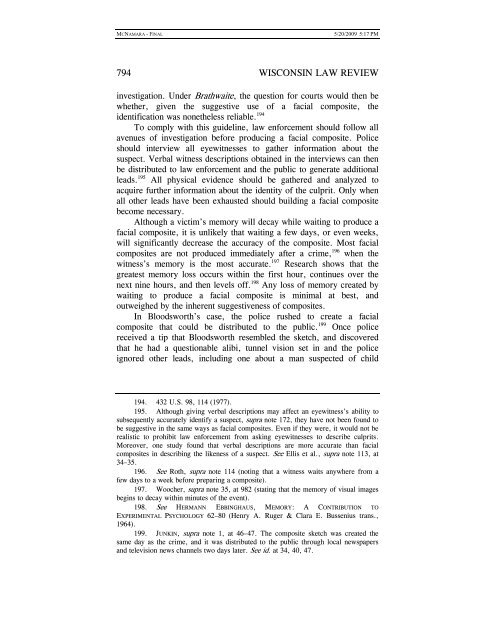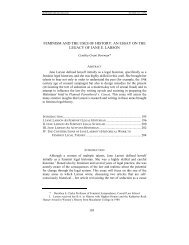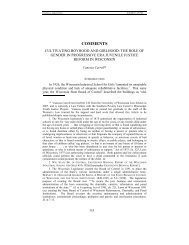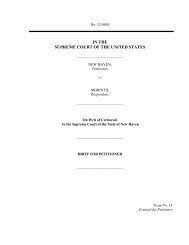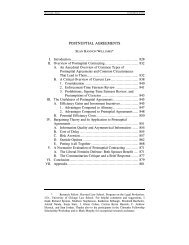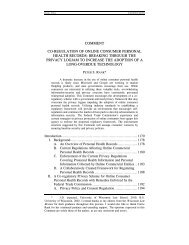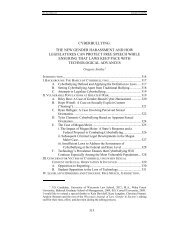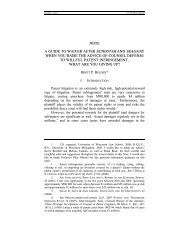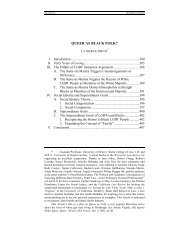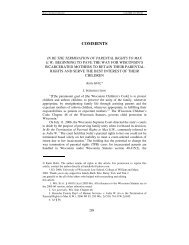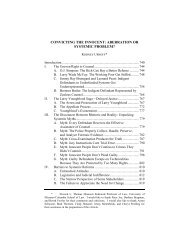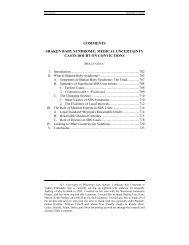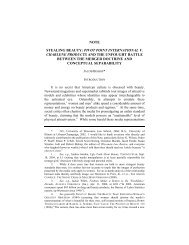comment sketchy eyewitness-identification ... - UW Law School
comment sketchy eyewitness-identification ... - UW Law School
comment sketchy eyewitness-identification ... - UW Law School
Create successful ePaper yourself
Turn your PDF publications into a flip-book with our unique Google optimized e-Paper software.
MCNAMARA - FINAL 5/20/2009 5:17 PM<br />
794 WISCONSIN LAW REVIEW<br />
investigation. Under Brathwaite, the question for courts would then be<br />
whether, given the suggestive use of a facial composite, the<br />
<strong>identification</strong> was nonetheless reliable. 194<br />
To comply with this guideline, law enforcement should follow all<br />
avenues of investigation before producing a facial composite. Police<br />
should interview all <strong>eyewitness</strong>es to gather information about the<br />
suspect. Verbal witness descriptions obtained in the interviews can then<br />
be distributed to law enforcement and the public to generate additional<br />
leads. 195 All physical evidence should be gathered and analyzed to<br />
acquire further information about the identity of the culprit. Only when<br />
all other leads have been exhausted should building a facial composite<br />
become necessary.<br />
Although a victim’s memory will decay while waiting to produce a<br />
facial composite, it is unlikely that waiting a few days, or even weeks,<br />
will significantly decrease the accuracy of the composite. Most facial<br />
composites are not produced immediately after a crime, 196 when the<br />
witness’s memory is the most accurate. 197 Research shows that the<br />
greatest memory loss occurs within the first hour, continues over the<br />
next nine hours, and then levels off. 198 Any loss of memory created by<br />
waiting to produce a facial composite is minimal at best, and<br />
outweighed by the inherent suggestiveness of composites.<br />
In Bloodsworth’s case, the police rushed to create a facial<br />
composite that could be distributed to the public. 199 Once police<br />
received a tip that Bloodsworth resembled the sketch, and discovered<br />
that he had a questionable alibi, tunnel vision set in and the police<br />
ignored other leads, including one about a man suspected of child<br />
194. 432 U.S. 98, 114 (1977).<br />
195. Although giving verbal descriptions may affect an <strong>eyewitness</strong>’s ability to<br />
subsequently accurately identify a suspect, supra note 172, they have not been found to<br />
be suggestive in the same ways as facial composites. Even if they were, it would not be<br />
realistic to prohibit law enforcement from asking <strong>eyewitness</strong>es to describe culprits.<br />
Moreover, one study found that verbal descriptions are more accurate than facial<br />
composites in describing the likeness of a suspect. See Ellis et al., supra note 113, at<br />
34–35.<br />
196. See Roth, supra note 114 (noting that a witness waits anywhere from a<br />
few days to a week before preparing a composite).<br />
197. Woocher, supra note 35, at 982 (stating that the memory of visual images<br />
begins to decay within minutes of the event).<br />
198. See HERMANN EBBINGHAUS, MEMORY: A CONTRIBUTION TO<br />
EXPERIMENTAL PSYCHOLOGY 62–80 (Henry A. Ruger & Clara E. Bussenius trans.,<br />
1964).<br />
199. JUNKIN, supra note 1, at 46–47. The composite sketch was created the<br />
same day as the crime, and it was distributed to the public through local newspapers<br />
and television news channels two days later. See id. at 34, 40, 47.


